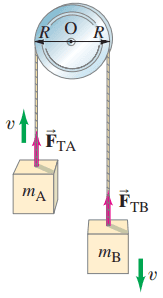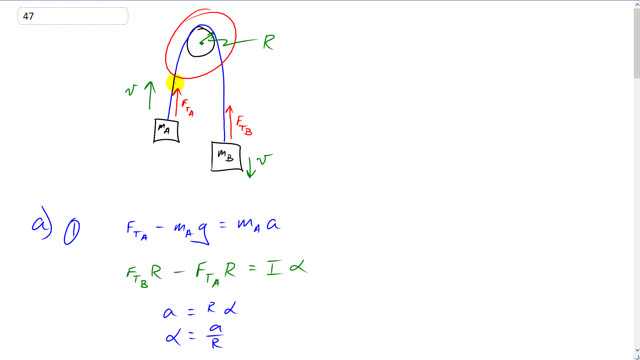
An Atwood machine consists of two masses, and , connected by a massless inelastic cord that passes over a pulley free to rotate, Fig. 8–52. The pulley is a solid cylinder of radius and mass 6.0 kg.
- Determine the acceleration of each mass.
- What % error would be made if the moment of inertia of the pulley is ignored? [Hint: The tensions and are not equal. We discussed the Atwood machine in Example 4–13, assuming for the pulley.]


In order to watch this solution you need to have a subscription.
This is Giancoli Answers with Mr. Dychko. So here we meet the Atwood machine again; we have seen this before in chapter 4 but now in chapter 8, it's a little bit more complicated because we have this pulley being not massless so we have to consider its moment of inertia in our calculations. So fasten your seat belt because that involves a bit of work. Now we are gonna start by defining our coordinate system: anything in this direction is positive so up and to the right and then down on the right hand side is positive. So that means when we consider mass A, the tension force up will be positive and gravity on A will be negative. When we consider block B, the tension force up will be negative and gravity on B will be positive because anything in this direction is positive so gravity on B is positive and tension on A is positive. And when we consider the pulley, the tension force on the side closest to mass B will be positive because it will be down on the pulley and the tension force A is gonna be down pulling in the negative direction on the pulley on the left side. Okay! So let's consider block A: the tension force upwards minus the gravity force downwards m A times g is the net force and so that equals its mass times its acceleration. We are taking acceleration to be positive in this direction and that's all we can say for mass A. And then consider the pulley: we have the net torque is moment of inertia times angular acceleration and I'm taking clockwise to be the positive direction here so that's why we have tension force B times the lever arm being positive and then tension force A times the lever arm being minus there and we can express this angular acceleration in terms of the tangental acceleration because points on the rim of this pulley will have the same acceleration as the blocks and the rope will because there's no slipping. And so tangental acceleration is the radius of the pulley times its angular acceleration and then divide, you know, both sides by R here and switch the sides around and we get α is a over R and then we can rewrite this formula factoring out the radius of the pulley and substituting in a over R in place of α. And then we turn our attention to block B and the gravity on block B m B g is positive and then the tension force upwards on block B is negative and that's gonna equal m B times a positive because we know this whole thing is accelerating like this since we are told... well anyway I'm assuming that it's accelerating that way and if I happen to be wrong, answers will work out to be negative so yeah let's take that to be the positive direction. Now we need to do some fancy algebra in order to solve for a: we have three equations and we need to combine them in such a way that we end up with an equation containing only the letter a that's unknown. So we don't know tension force A and we don't know tension force B and I can see that there's a difference here in equation (2) where we are taking the difference between the two tension forces there. So if we can manipulate equations (1) and (3) to create an expression for the difference in the tension forces that means we can make a substitution here and it turns out that when we do that, we'll have an equation containing the only unknown being a. So let's take equation 3 version b, we are gonna solve it for tension force B so we take this to the right hand side making it positive and take this term to the left making it minus. So tension force B is m Bg minus m Ba and then manipulate equation 1 a little bit to solve for tension force A and that's gonna be m Ag plus m Aa when we take this term to the right hand side, it becomes positive. And then equation 3b minus equation 1b that's gonna be tension force B minus tension force A when you subtract the left hand sides and then the right hand sides is m Bg minus m Ba— just copying tension force B there— and then minus both of these so minus m Ag minus m Aa. And this can be substituted directly into equation 2 in place of this because it's F T B minus F T A and doing so is strategic because now we have this equation where I have copied equation 2 and written version b and written this in place of that difference in the tension forces and the only thing we don't know is a so let's do some algebra to solve for it. (So what did I do?) Divided both sides by R and that makes Ia over R squared here for this term and then that gets rid of the brackets when we do that and so then we can add this term and this term to both sides and basically we are trying to collect all the terms that contain our unknown a and then leave the other stuff on the other side of the equation switching the sides around as well so we have m Bg minus m Ag on their own on one side of the equation and then we have an Ia over R squared plus m Ba plus m Aa on the other side of the equation. And then we'll factor out a and then divide both sides by the thing that the a gets multiplied by so I over R squared plus m B plus m A so that's why it's in the denominator there and then on the right hand side, I just factored out the g. And so we have acceleration equals this and we'll make some substitutions again for moment of inertia. So moment of inertia for a uniform disk is one-half mass times its radius squared— this is mass of the pulley here by the way— but what's even better is if we substitute for I over R squared so let's take this thing and divide it by R squared and what we end up with is mass R squared over 2R squared which is m over 2. So this fraction I over R squared can be replaced by m over 2 so that's what I wrote here and I like to do substitution's in red don't I so let's write that. So we have acceleration is g times m B minus m A all over m over 2 plus m B plus m A. So plug and chug 9.8 meters per second squared times 75 kilograms minus 65 kilograms divided by 6.0 kilograms over 2 plus 75 plus 65 gives us 0.69 meters per second squared will be the acceleration of the system. There! Now if I was 0, then F T B minus F T A would equal 0 in other words, the tension forces would be the same so there would be no difference between them and then this expression we made up here would be 0 so I'm just gonna rewrite this part here below... here. And then solving for a, we take this term to the right, this term to the right, they both become positive, factor out the a and then take what's left behind g factored out from the m B minus m A and divided by m A plus m B and this is a formula we created in chapter 4 when we did the Atwood machine without any moment of inertia for the pulley. So we have 9.8 meters per second squared times the difference in masses divided by the sum of the masses and that's 0.70 and so the percent error is gonna be that 0.70 minus the answer we calculated in part (a) divided by that answer and that gives about 2 percent and that's a fairly small error because the mass of the pulley is fairly small. And if you compare this formula to the one we created here, you can see that the only difference is this little term there for the... that's what results from the moment of inertia of the pulley.